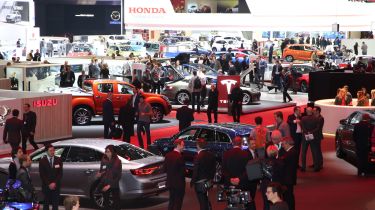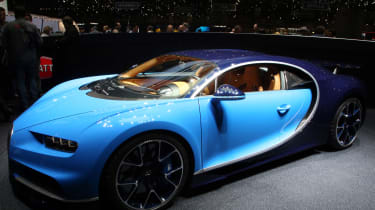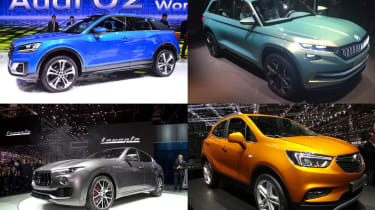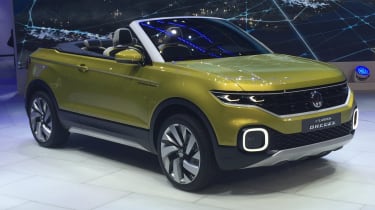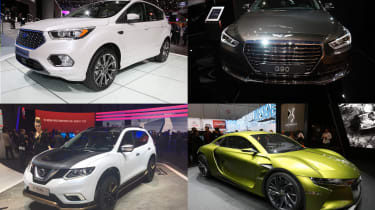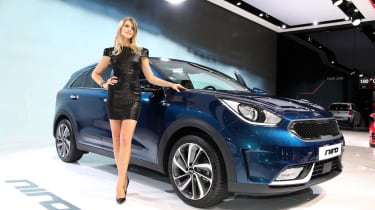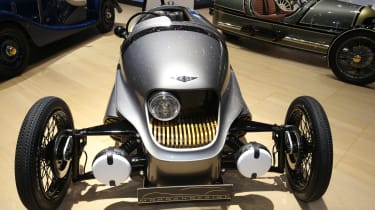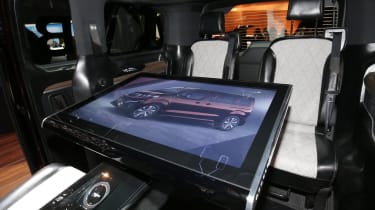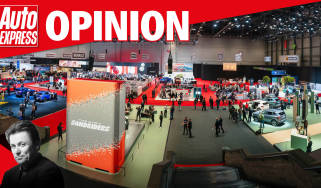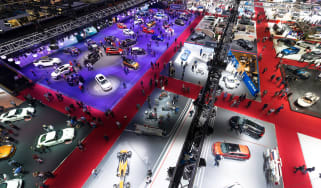Nine things we learned at the 2016 Geneva Motor Show
The dust has settled on the Geneva Motor Show press days so here’s what we learned at the world’s best car show in 2016
Another Geneva Motor Show explodes into a galaxy of gleaming metal and begins its long fade into memory. The car industry has, once again, given us a rough approximation of where it’s at and lifted the curtain an inch or two on where it’s going, but what does it all mean?
As the world’s most influential motor show, Geneva is in a unique position to act as a barometer for the industry. It’s a regular point where we can take stock and look at the bigger picture in what are particularly turbulent times for the world of cars.
• Best cars at the 2016 Geneva Motor Show
How do brands plan to respond to the assortment of challenges facing them, from emissions to the march of in-car connectivity and autonomous driving? How will these decisions impact on the way our cars look and drive in the future? True to form, Geneva didn’t provide one answer to any of these questions, it came up with a whole quiz show worth.
Different manufacturers mapped out their sometimes disparate approaches to the problems of selling cars next year, but also in five, 10 and 20 years time - trying to put one over on the competition in the process. It was fun to watch, and try to make sense of.
So below are some of the important, and less important, things we think we’ve learned after two days staring at highly polished cars slowly rotating under very hot lights at the 2016 Geneva Motor Show…
Nine things we learned at Geneva 2016
1. Hypercar makers have finally parted company with reality
Bugatti only has itself to blame. When it launched the Veyron and instantly redefined what was possible in a high performance road car, rivals were left floundering in its wake. At Geneva, we saw the next leg of Bugatti’s incredible journey, the Chiron, and incredible it undoubtedly is. But the Chiron’s ludicrous numbers (1,479bhp, a limited 261mph and £1.9m) don’t smash the competition out of the park in the way the Veyron’s once did.
These days, people with an insane amount of money to spend on a car that will eat the 200mph barrier and ask for seconds have options. They might not be on the Bugatti Chiron’s level in terms of development and maybe even quality but after 11 years with the Veyron as a target, the other super-exotic hypercars can compete - from the safety of a motorshow stand at least.
The 1,480bhp+ Koenigsegg Regera and the 2,080bhp Arash AF10 both out-muscled the Chiron on its opening night. Of course, the use of electric assistance in these cars does mean they could virtually claim any power output they liked and nobody would really be able to say any different.
2. The crossovers keep coming
It’s been the defining trend in the new car market over the last few years but the incredible growth of the crossover niche is finally finished. Yes, crossovers are very much the mainstream in 2016.
The brands holding out against the relentless tide of jacked-up suspension and chunky bumpers seem to be dwindling by the month. Ferrari is still metaphorically down on the beach with the water lapping over its Armani loafers but it cuts an increasingly lonely figure. Geneva brought us the Skoda VisionS concept (soon to be the Kodiaq production car), the SEAT Ateca, Vauxhall’s Mokka X, Maserati’s Levante, the Audi Q2, Toyota’s C-HR and many, many others. All are crossovers of a sort but they’re targeting a number of different sections of the expanding and segmenting crossover SUV market that everyone’s vying for a slice of.
Meanwhile, even cars that aren’t crossovers are disguising themselves as such. The new Renault Scenic is aiming to tempt back some of the family buyers who vacated their MPVs for the taller driving positions and trendier looks in the crossover market by borrowing crossover design cues. We’re expecting the Vauxhall Zafira and Meriva MPVs to do the same in the near future.
What’s impressive in all this is how quickly and strongly the car industry moves to exploit an opportunity to sell more cars. Back in 2006 the public had never heard of a crossover then Nissan launched the Qashqai and the rest is history.
3. Convertible crossovers are in danger of becoming a thing too
The crossover boom means that if you’re one of the few remaining people who still holds an ingrained dislike for road cars with off-roader overtones, the car world is not going to be a happy place for you in the coming months. Observers of that disposition probably put the Citroen e-Mehari concept from last year’s Frankfurt show down as an oddity and the Range Rover Evoque Convertible as a one-off aberration but at Geneva, the Volkswagen T-Cross Breeze concept evoked the old adage about two being a coincidence but three being a trend. You have been warned.
4. ‘Premium’ is where the money is
Alongside the unstoppable rise of the crossover, the diversification of premium brands has been a defining trend in the car market over recent years. The likes of BMW, Audi and Mercedes have been pushing their brand power into smaller and more affordable cars, squeezing the mainstream marques in the process. At Geneva 2016 we saw the backlash gather pace, PSA’s DS brand and Ford’s Vignale bearing the standard for the mainstream’s attempted push into the premium space.
What ‘premium’ actually looks, feels and smells like is a hard thing to pin down but in car making terms it’s a licence to charge an extra £1k-£3k for your cars, so it has obvious attraction. As well as DS and Vignale, Hyundai’s new Genesis brand was also represented by the G90 and Nissan tested the water with high spec Premium Concept versions of its X-Trail and Qashqai. Trying to get the public to value these new would-be premium brands alongside the established names will be a challenge but the long road starts here.
5. Never mind the car, look at those wheels!
Car designers will always emphasise how important the wheels are to the look of any car. That explains why so many of the models on display at motor shows have huge wheel and super-thin tyre combos that would serve up a ride rougher than a bathtub crossing of the Atlantic on the average British B-road. That said, the wheel area seemed to be a particular design focus at Geneva and we spotted some fantastic efforts from the Bugatti Chiron’s delicate rims to the Pagani Huayra with its huge orange brake callipers and, of course, the red front tires of the Vauxhall GT.
6. Hybrid is about to have its day…
Emissions from petrol and diesel cars have never been under harsher scrutiny and Geneva saw the leading brands setting out their stalls for a cleaner, greener future.
Great strides have already been made in improving conventional engine efficiency in recent years and PSA’s move to reveal real world fuel economy figures for its cars at Geneva will help ease motorists’ frustrations with the perceived discrepancies between official test results and the actual mpg they get on the road.
Cars are going to have to get even greener though and a consensus seems to be forming that the next step is hybrid. Hyundai’s Ioniq is the first car offered as a hybrid, a plug-in hybrid and a pure EV, while Kia revealed its Niro crossover with similar hybrid tech. Longstanding hybrid champion Toyota revealed the C-HR hybrid crossover, Skoda’s VisionS had hybrid power and SsangYong showed the SIV-2 concept - another crossover with electric assistance. There were also noises from BMW, Mercedes, Audi, Volkswagen and many others about up to half of their ranges using some form of hybrid tech by 2020.
7. …but the full EVs are waiting in the wings
So there’ll be more hybrids on the road in the coming years but what happens after that? Speak to Nissan and hybrid is just stopping off point on the route to full EVs. While other brands were talking about electrical assistance for their internal combustion engines, Nissan was setting out details of new battery tech that will take its EVs over the magic 550km (341-mile) range barrier. At that point, says Nissan, range anxiety starts to disappear and it’s only the cost of the battery that’s proving a stumbling point.
Tesla’s electric car success story continues too with the European debut of the Model X SUV and its ‘falcon wing’ doors but the variety of all-electric cars is expanding as well. McLaren announced it is considering an all electric successor to the P1 hypercar, Rimac showed the remarkably complex 220mph Concept_One and even Morgan got in on the EV act with the EV3 electric 3-wheeler.
8. The age of the sexy Lexus and the tasty Toyota may have arrived
Toyota is the world’s biggest car marker so it must be doing something right but in its successful search for mass market appeal, its products have sometimes been a little lacking in the style department. The same could be said for Toyota’s premium brand, Lexus. It’s tried hard but too often failed to achieve the cool, clinical image perfected buy its German rivals.
But did Geneva 2016 quietly usher in a new era of stylish, confident design for Toyota and Lexus? The Lexus LC500h has already been widely admired and in the metal on the Lexus stand at Geneva, it seduced a fair few more. More noteworthy was the Toyota C-HR. We’d seen the concept car of the same name at Frankfurt in 2015, it looked great and we fully expected it to be comprehensively toned down in production guise. Not a bit of it, the bold lines of the concept have been largely retained to create what might be the most striking design seen in any Toyota showroom since the cleaner traded up to a Dyson.
9. Screens, and screen envy, are growing
If you browsed around the concept cars at Geneva that actually had interiors, a definite trend started to emerge - the giant touch screen display. The connected car is already with us and it seems the next generation of in-car tech will make it easier and more rewarding to use all those internet enabled features.
Tesla set the trend for screen expansion and its giant portrait offering was shown in the Model X that made its European debut that the show. Renault has followed suit with the new Megane and Scenic too but the latest Geneva concepts took things to the next level.
The DS e-Tense concept sported a specially sculpted dash that brought the screen out alongside the driver, the Volkswagen Budd-e popped up again with its home cinema screen in the rear but it was Peugeot’s Traveller iLab that took the popcorn with a vast touchscreen display doubling as a table. At least we’ll all have something to keep us entertained while we’re being ferried from A to B in the autonomous cars of the future.
What did you learn from the new car news that came out of the 2016 Geneva Motor Show? Let us know in the comments section below...
Find a car with the experts

